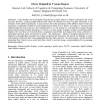Free Online Productivity Tools
i2Speak
i2Symbol
i2OCR
iTex2Img
iWeb2Print
iWeb2Shot
i2Type
iPdf2Split
iPdf2Merge
i2Bopomofo
i2Arabic
i2Style
i2Image
i2PDF
iLatex2Rtf
Sci2ools
INTERACT
2003
2003
Enticing People to Interact with Large Public Displays in Public Spaces
: Large displays are increasingly being placed in public places to support community and social activities. However, a major problem that has been observed with this new form of public interaction is the resistance by the public to participate. A main reason is due to the prominence of the affective aspect of the user experience. In particular, feelings of social embarrassment often act as a barrier. Our paper is concerned with understanding why this is the case and considering how we can attempt to overcome these aspects through improving the design of public interaction. Our focus is on how groups of people socialize around large public displays, the way they move towards them, congregate around them and change from being onlookers to participants and back again. We describe a system – the Opinionizer – which we designed and placed in two authentic social gatherings, intended to encourage socializing and interaction. We present our findings in terms of the patterns of physical an...
Related Content
| Added | 31 Oct 2010 |
| Updated | 31 Oct 2010 |
| Type | Conference |
| Year | 2003 |
| Where | INTERACT |
| Authors | Harry Brignull, Yvonne Rogers |
Comments (0)

